Hanging Art With Wire and a Cross W Technique
For 38+ years, creatives accept looked to Creative person'south & Graphic Designer's Marketplace for the best business organisation tips and communication. The latest edition includes 1,700+ market place contact listings also as elevation-notch business organization articles and inspiring interviews with professionals in your field. Proceed reading for a 2013 AGDM article by artists Jonathan and Marsha Talbot. Yous tin observe more than from Artist's & Graphic Designer'due south Market on ArtistsMarketOnline.com.
Installing a solo show of your own work is a challenging and rewarding task. A solo evidence is probably something you've worked toward for a year or more than. You have a substantial emotional investment—and frequently an economic one too—in its success. If your show is in a museum or commercial gallery, installing the show volition nigh likely exist the responsibility of the museum curator or gallery director. But if your prove is in a co-op gallery, art association, culling art space, library, bank, restaurant, function space or your own studio, part or all of the responsibility for arranging and hanging the work will probably fall on your shoulders. Exploring the installation process will help yous create a cohesive exhibition that will bear witness your work to its all-time advantage.
Things to consider
The first challenge is to recognize that, while the works yous've created for the exhibition are the reason for the testify, the exhibition is not well-nigh the works. Instead, the exhibition is a work of art unto itself. Your artworks are but one component of that larger work—the exhibition.
Creating an exhibition is a multidimensional process. Amidst the factors that contribute to a success or failure are the exhibition space, the lighting, the viewers and the way they will move through the space, visual distractions that are unavoidable, attending to your main purpose for the exhibition, the mechanics of how the artwork will be hung, and the arrangement of the pieces.
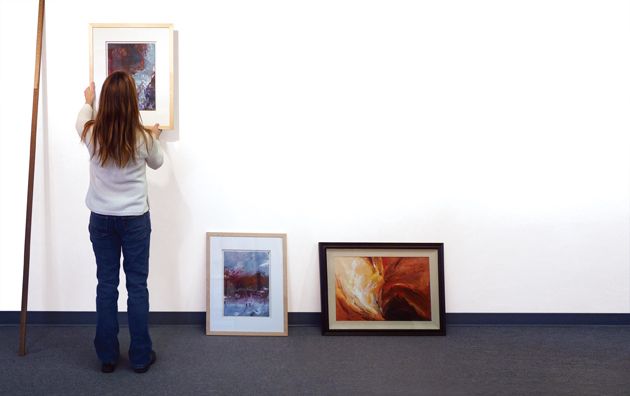
Photos and illustrations by Jonathan Talbot unless otherwise noted.
The infinite
First by clearing the infinite as completely as possible. Even if in that location are pedestals, chairs or other furniture that you imagine yous'll utilise in setting upwards your exhibition, remove them at this betoken so you tin come across the space with as few distractions as possible.
When the space is empty, examine your environs. Is in that location any natural light? How many entrances and exits are at that place? Are there any pillars, unmovable dividing walls or other obstructions in the space? Do the walls need to exist touched up? Is the ceiling high or low? Is there sufficient lighting? Is in that location anything in or nigh the space that volition compete with your work for the viewers' attention?
After you've addressed these questions and whatsoever others that occur to you lot, it's time to bring your works into the space—if possible, into the center of the space. Don't lean the works confronting the walls at this point—they'll become an impediment to envisioning the best possible layout of your show.
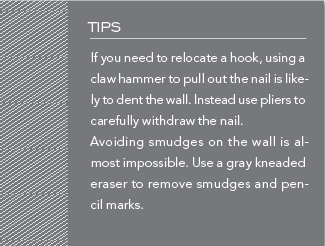 The works
The works
Your fine art is the raw material of the show. Ideally you'll accept more piece of work than you need to fill the space because this will requite you options as you create your exhibition.
Here are a few points you lot may want to consider: Do y'all have more piece of work than you need or not enough for this particular space? Are any of your artworks in serial? If then, must the serial exist hung together? Are the majority of the works large or small?
The most frequent mistake that artists make when hanging their own shows is including too much work. It's a natural fault. Yous want to share as much of your fine art as possible with the public. Maybe you likewise think that the more you hang, the more you'll sell (not true). Quality, not quantity, should govern your decisions. Sometimes less is more. The integrity of the show itself, the success of the system and the visual affect of the works, both collectively and individually, are far more important than the number of pieces on display.

The works & the space
The starting time step in determining what goes where is to consider how viewers will enter the space and what they'll see first. If there's a wall straight opposite the primary entrance, the visitor's gaze will likely go at that place offset. But if in that location's an exit opposite the master entrance or if the works on the opposite wall are small and far abroad, viewers are likely to turn to their right.
The side by side footstep is to lean works informally against the wall. By doing this, you tin can constitute an approximate organization without the commitment of attaching nails or hooks in any specific locations. It's important to stay flexible during this phase of the process. Pieces initially placed in one location may be moved 3, four or fifty-fifty more than times before finding their last position.
Create an interesting arrangement. No one wants to see an uninteresting show, and such a prove won't do your works justice. Try to see the exhibition from a company's perspective. Continuity is important, but sometimes group like works together can be slow. Consider creating visual syncopation by breaking big groups into smaller blocks of diff size and leaving space between them. Consider creating groupings of some works while displaying others singly. A group of smaller works can balance the affect of a larger work that adds power to a detail part of the exhibition. A small work resting on an easel atop a pedestal can draw viewers to a corner that they might otherwise pass by. (Meet photos A and B.)
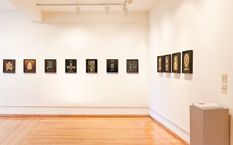

In this surface area of Loel Barr'due south solo exhibition at the Woodstock Artists Association and Museum, the preliminary arrangement in picture A is perfectly acceptable, just interest and energy were added for the final installation by replacing some of the hanging works with three-dimensional constructions placed on shelves and a pedestal as shown in picture B.
Photos by John Kleinhans
Don't forget to stay flexible. Sometimes it may be necessary to move an entire group of works from 1 wall to another as the arrangement evolves. If you're hanging works in more than than 1 row, lay them on the floor as you lot create a grouping and move the entire grouping to the wall only when yous believe you're finished. Even then, be open to the possibility that last-minute changes may be needed.
If yous have a friend who's experienced in hanging exhibitions, consider request for help in hanging yours. A second opinion is every bit of import in art as it is in medicine, and the fact that someone else sees your work objectively may help to balance your ain intimate involvement with information technology.
The mechanics of hanging
When y'all're ready to hang the works on the wall, you'll need hooks or nails for hanging, a pencil, a hammer, pliers (make sure they also cut wire), a record measure at least 8 feet long and a kneaded grayness eraser. A four- or six-foot level and some extra picture show wire for emergencies are also good to accept handy. You can save considerable time if you lot make a "hanging gauge." (Run into "How to Make and Use a Hanging Estimate.")
The average homo centre tiptop is approximately 62 inches, and many galleries and museums try to position works of art with the center of the work, measured vertically, at this level. The easy style to exercise this is to measure the total height of the framed work, divide that amount past 2, and subtract the distance between the wire (stretch information technology taught with one finger) and the top of the frame. Add the consequence to 62 inches and measure from the floor up to position the hook or smash that volition hold that work. Using the estimate—where the ruler starts at 62 inches in a higher place the floor—eliminates the last calculation.
![]()
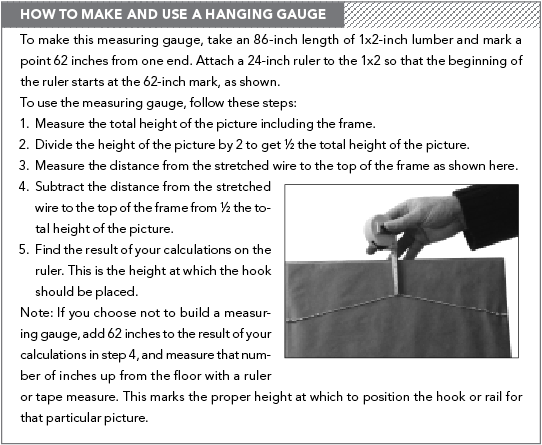
Sometimes y'all may want to hang a grouping of same-size works in a row. In this case using a level may be more effective than measuring from the floor as the floor itself may non be level. The varying length and tension of the wires on the back of the frames may also make adjustment the works hard. In this case, specially if you're using gimmicky frames with infinite in the back, information technology may be useful to ignore or remove the wire and hang the aforementioned-size works with the frames themselves resting on pairs of nails driven in on a level line.
In the special instance where you lot're hanging your works from picture rail moulding, using a continuous loop of wire helps to become the works level at the height you want. Tie the wire to one moulding claw, run it through both screw eyes on the back of the frame, and and so tie it to the other motion-picture show hook (see "Hanging From Picture Rails Moulding"). If y'all're on the ladder, have someone else mensurate the height of the work. Final leveling requires only sliding the moving-picture show up or downwardly on 1 side or the other.
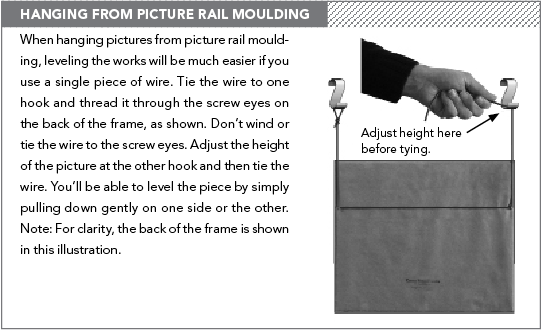
Lighting the work
Almost exhibition spaces have rails lighting of some kind. Brand sure that the lights are directed so they best heighten your work. All besides oftentimes there aren't as many lights every bit in that location are works. When this happens, lighting from an angle, or cross-lighting, enables y'all to light more than i work with the same fixture (see photos C and D). In general, using floodlights—rather than spotlights that can create hot spots—is all-time.


When direct lighting doesn't spread the low-cal well enough or when there aren't enough lights (C), cross-lighting the works allows for better coverage and more even, pleasing lighting (D).
Finishing upwardly
A few things remain to be washed before the opening. First, y'all should photograph your prove. Utilize a tripod and plow off the flash on your camera to avoid reflections from works that have drinking glass or are varnished. Don't include people in your photographs. What you should create is a photographic document showing the exhibition as a whole.
2nd, prepare a guest book. Getting the names and e-mail addresses of the visitors to your exhibition can be a large help in growing your mailing list and your career. Most shop-bought guest books don't include enough room for e-mail addresses, and then nosotros've designed pages that can be inserted in a clean loose-leafage binder that's left open, with a pen, on a table or pedestal. These printable pages, in both Microsoft Give-and-take and PDF formats, tin can exist institute at www.artistsnetwork.com/article/talbot-exhibition-invitee-book-folio.
Third, think nearly refreshments; customs vary past location and tradition. Practise consider, still, that devoting besides much infinite to food and drink may make the refreshments, rather than your works, the focus of the opening.
Lastly, take a deep breath. Forget all the effort it took to make the work and all the effort information technology took to hang the evidence. Have a good time.
Jonathan and Marsha Talbot have been installing solo, grouping and theme exhibitions together for more than 40 years. Visit Jonathan'south website at www.talbot1.com.
Excerpted from the June 2011 issue of The Artist's Mag. Used with the kind permission of The Artist'southward Magazine, a publication of F+W Media, Inc. Visit www.artistsnetwork.com to subscribe.
Source: https://www.artistsnetwork.com/art-business/art-hanging-systems/
0 Response to "Hanging Art With Wire and a Cross W Technique"
Post a Comment